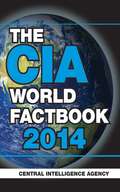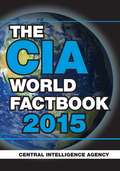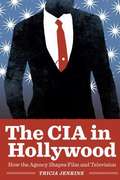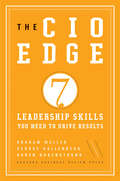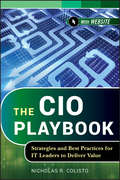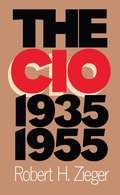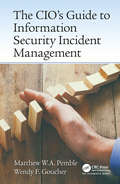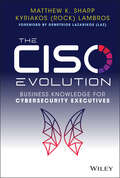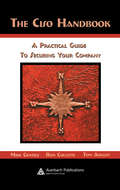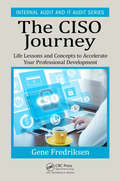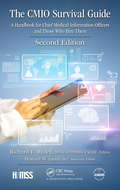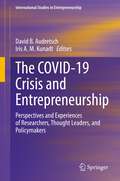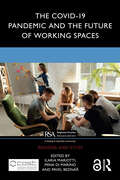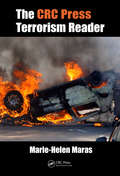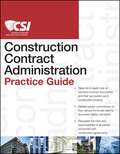- Table View
- List View
The CFO as the Architect of Adaptive Management
by Jeremy HopeDespite a number of compelling reasons to move away from annual plans and budgets, many CFOs are reluctant to make the change. They fail to recognize that there are alternative (and less dysfunctional) ways of driving performance improvement and making managers accountable for performance. CFOs need to implement systems that provide managers at every level with the capability to make fast, well-informed decisions. They need to replace annual planning cycles with more regular business reviews that enable managers to see trends, patterns, and "breaks in the curve" long before the competition. This chapter serves as a guide. This chapter is excerpted from "Reinventing the CFO: How Financial Managers Can Transform Their Roles and Add Greater Value."
The CIA World Factbook 2014
by Central Intelligence AgencyFrom Afghanistan to Zimbabwe, The CIA World Factbook 2014 offers complete and up-to-date information on the world’s nations. This comprehensive guide is packed with detailed information on the politics, populations, military expenditures, and economics of 2014.For each country, The CIA World Factbook 2014 includes: Detailed maps with new geopolitical data Statistics on the population of each country, with details on literacy rates, HIV prevalence, and age structure New data on military expenditures and capabilities Information on each country’s climate and natural hazards Details on prominent political parties, and contact information for diplomatic consultation Facts on transportation and communication infrastructure And much more!Also included are appendixes with useful abbreviations, international environmental agreements, international organizations and groups, weight and measure conversions, and more. Originally intended for use by government officials, this is a must-have resource for students, travelers, journalists, and businesspeople with a desire to know more about their world.
The CIA World Factbook 2015
by Central Intelligence AgencyFrom Afghanistan to Zimbabwe, The CIA World Factbook 2015 offers complete and up-to-date information on the world’s nations. This comprehensive guide is packed with detailed information on the politics, populations, military expenditures, and economics of 2015.For each country, The CIA World Factbook 2015 includes:Detailed maps with new geopolitical dataStatistics on the population of each country, with details on literacy rates, HIV prevalence, and age structureNew data on military expenditures and capabilitiesInformation on each country’s climate and natural hazardsDetails on prominent political parties, and contact information for diplomatic consultationFacts on transportation and communication infrastructureAnd much more!Also included are appendixes with useful abbreviations, international environmental agreements, international organizations and groups, weight and measure conversions, and more. Originally intended for use by government officials, this is a must-have resource for students, travelers, journalists, and business people with a desire to know more about their world.
The CIA in Hollywood: How the Agency Shapes Film and Television
by Tricia JenkinsWhat’s your impression of the CIA? A bumbling agency that can’t protect its own spies? A rogue organization prone to covert operations and assassinations? Or a dedicated public service that advances the interests of the United States? Astute TV and movie viewers may have noticed that the CIA’s image in popular media has spanned this entire range, with a decided shift to more positive portrayals in recent years. But what very few people know is that the Central Intelligence Agency has been actively engaged in shaping the content of film and television, especially since it established an entertainment industry liaison program in the mid-1990s. The CIA in Hollywood offers the first full-scale investigation of the relationship between the Agency and the film and television industries. Tricia Jenkins draws on numerous interviews with the CIA’s public affairs staff, operations officers, and historians, as well as with Hollywood technical consultants, producers, and screenwriters who have worked with the Agency, to uncover the nature of the CIA’s role in Hollywood. In particular, she delves into the Agency’s and its officers’ involvement in the production of The Agency, In the Company of Spies, Alias, The Recruit, The Sum of All Fears, Enemy of the State, Syriana, The Good Shepherd, and more. Her research reveals the significant influence that the CIA now wields in Hollywood and raises important and troubling questions about the ethics and legality of a government agency using popular media to manipulate its public image.
The CIM Marketing Dictionary
by Norman Hart John StapletonThe CIM Marketing Dictionary the 5th edition of the best-selling Dictionary of Marketing now contains over 3,000 terms. This greatly expanded dictionary spans the complete range of present-day marketing and associated terminology. Marketers will also find over 400 new entries covering the latest jargon they need to know in IT. In compiling this selection, the editor has drawn on his own extensive experience and sought the views of all the leading trade and professional associations. The CIM Marketing Dictionary will prove invaluable to all marketing professionals including marketing managers and directors, sales, marketing communications managers, specialists involved in purchasing, export and many other fields. Students of this subject will also find this book an essential reference point.
The CIO Edge
by George Hallenbeck Karen Rubenstrunk Graham WallerGreat CIOs consistently exceed key stakeholders' expectations and maximize the business value delivered through their company's technology. What's their secret?Sure, IT professionals need technological smarts, plus an understanding of their company's goals and the competitive landscape. But the best of them possess a far more potent ability: they forge good working relationships with everyone involved in an IT-enabled project, whether it's introducing new hardware or implementing a major business transformation.In The CIO Edge, the authors draw on Korn/Ferry International's extensive empirical data on leadership competencies as well as Gartner's research on IT trends and the CIO role. They prove that, for IT leaders, mastering seven essential skills yields big results.This new book lays out the people-to-people leadership competencies that the highest-performing CIOs have in common-including the ability to inspire others, connect with a diverse array of stakeholders, value others' ideas, and manifest caring in their relationships. The authors then explain how to cultivate each defining competency.Learn these skills, and you'll get more work done through others' enabling you to successfully execute more IT projects, generate better results for your company, and concentrate your efforts where they'll exert the most impact. The payoff? As the authors show, you'll work smarter, not harder-and get promoted far faster than your peers.
The CIO Paradox: Battling the Contradictions of IT Leadership
by Martha HellerRegardless of industry, most major companies are becoming technology companies. The successful management of information has become so critical to a company's goals that in many ways, now is the age of the CIO. Yet IT executives are besieged by a host of contradictions: bad technology can bring a company to its knees, but corporate boards rarely employ CIOs; CIOs must keep costs down at the very same time that they drive innovation. CIOs are focused on the future, while they are tethered by technology decisions made in the past. These contradictions form what Martha Heller calls The CIO Paradox, a set of conflicting forces that are deeply embedded in governance, staffing, executive expectations, and even corporate culture. Heller, who has spent more than 12 years working with the CIO community, offers guidance to CIOs on how to attack, reverse, or neutralize the paradoxical elements of the CIO role. Through interviews with a wide array of successful CIOs, The CIO Paradox helps readers level the playing field for IT success and get one step closer to bringing maximum value to their companies. The book addresses four vantage points for CIOs to consider as they move toward improvement: their particular Role, their Stakeholders, their Organization, and their particular Industry. When fully understood, these four aspects of IT leadership work in concert to comprise what Heller considers to be a winning formula for excellence.
The CIO Playbook: Strategies and Best Practices for IT Leaders to Deliver Value (Wiley CIO #585)
by Nicholas R. ColistoAs our economy shifts from recession to recovery, our current economic climate is ripe for transformation. CIOs are in a unique position to leverage technology in order to drive innovation and boost business growth. The CIO Playbook is the handy desk reference for CIOs, CEOs, CFOs, and up and coming leaders, revealing a dynamic seven-step framework (Partner – Organize – Innovate – Deliver – Support – Protect – Grow) that will guide you in making essential changes to your organization. The proven strategies, tools, and techniques in The CIO Playbook make it the ultimate "how-to" resource for creating a high-performance IT organization that delivers value-added products and services to employees, customers, and shareholders. Author Nicholas Colisto provides solutions to the issues that concern business leaders and IT practitioners, including: How to truly partner with business peers Delivering high-quality products and services that are embraced by your user community How to ensure your team is focused on the right innovations Measuring performance and running your department like a business Ways to attract, motivate, and retain a talented team working toward a common vision Managing risks to operate effectively and protect corporate reputation Featuring online templates for each of the seven steps described in the book, The CIO Playbook can help you transform your IT department from a mere order taker to a high-performance organization that delivers extraordinary business outcomes, despite this era of turbulent economic challenges.
The CIO's Guide to Oracle Products and Solutions
by Jessica KeyesFrom operating systems to the cloud, Oracle's products and services are everywhere, and it has the market share to prove it. Given the share diversity of the Oracle product line, and the level of complexity of integration, management can be quite a daunting task.The CIO's Guide to Oracle Products and Solutions is the go-to guide for all things Orac
The CIO, 1935-1955
by Robert H. ZiegerThe Congress of Industrial Organizations (CIO) encompassed the largest sustained surge of worker organization in American history. Robert Zieger charts the rise of this industrial union movement, from the founding of the CIO by John L. Lewis in 1935 to its merger under Walter Reuther with the American Federation of Labor in 1955. Exploring themes of race and gender, Zieger combines the institutional history of the CIO with vivid depictions of working-class life in this critical period. Zieger details the ideological conflicts that racked the CIO even as its leaders strove to establish a labor presence at the heart of the U.S. economic system. Stressing the efforts of industrial unionists such as Sidney Hillman and Philip Murray to forge potent instruments of political action, he assesses the CIO's vital role in shaping the postwar political and international order. Zieger's analysis also contributes to current debates over labor law reform, the collective bargaining system, and the role of organized labor in a changing economy.
The CIO’s Guide to Information Security Incident Management
by Matthew William Pemble Wendy Fiona GoucherThis book will help IT and business operations managers who have been tasked with addressing security issues. It provides a solid understanding of security incident response and detailed guidance in the setting up and running of specialist incident management teams. Having an incident response plan is required for compliance with government regulations, industry standards such as PCI DSS, and certifications such as ISO 27001. This book will help organizations meet those compliance requirements.
The CISO Evolution: Business Knowledge for Cybersecurity Executives
by Matthew K. Sharp Kyriakos LambrosLearn to effectively deliver business aligned cybersecurity outcomes In The CISO Evolution: Business Knowledge for Cybersecurity Executives, information security experts Matthew K. Sharp and Kyriakos “Rock” Lambros deliver an insightful and practical resource to help cybersecurity professionals develop the skills they need to effectively communicate with senior management and boards. They assert business aligned cybersecurity is crucial and demonstrate how business acumen is being put into action to deliver meaningful business outcomes. The authors use illustrative stories to show professionals how to establish an executive presence and avoid the most common pitfalls experienced by technology experts when speaking and presenting to executives. The book will show you how to: Inspire trust in senior business leaders by properly aligning and setting expectations around risk appetite and capital allocation Properly characterize the indispensable role of cybersecurity in your company’s overall strategic plan Acquire the necessary funding and resources for your company’s cybersecurity program and avoid the stress and anxiety that comes with underfunding Perfect for security and risk professionals, IT auditors, and risk managers looking for effective strategies to communicate cybersecurity concepts and ideas to business professionals without a background in technology. The CISO Evolution is also a must-read resource for business executives, managers, and leaders hoping to improve the quality of dialogue with their cybersecurity leaders.
The CISO Handbook: A Practical Guide to Securing Your Company
by Michael Gentile Ron Collette Thomas D. AugustTruly a practical work, this handbook offers a comprehensive roadmap for designing and implementing an effective information security program based on real world scenarios. It builds a bridge between high-level theory and practical execution by illustrating solutions to practical issues often overlooked by theoretical texts. This leads to a set of practices that security professionals can use every day. The framework it describes can be expanded or contracted to meet the needs of almost any organization. A reference as well as a guide, each of the chapters are self-contained and can be read in any order.
The CISO Journey: Life Lessons and Concepts to Accelerate Your Professional Development (Internal Audit and IT Audit)
by Eugene M FredriksenThe book takes readers though a series of security and risk discussions based on real-life experiences. While the experience story may not be technical, it will relate specifically to a value or skill critical to being a successful CISO. The core content is organized into ten major chapters, each relating to a "Rule of Information Security" developed through a career of real life experiences. The elements are selected to accelerate the development of CISO skills critical to success. Each segments clearly calls out lessons learned and skills to be developed. The last segment of the book addresses presenting security to senior execs and board members, and provides sample content and materials.
The CME Group Risk Management Handbook
by Peterson John W. Null John E. Paul E. Leo Melamed Labuszewski Nyhoff Richard CoPraise for The CME Group Risk Management Handbook "Wow! The CME Group Risk Management Handbook is a 'ten strike' and long overdue. A must-read and reference for the risk management industry!" -Jack Sandner, retired chairman of CME Group, member of the Executive Committee "This is a powerful book for its integration of futures and options markets with an understanding of the whole economy. It is an eye-opener to see how central these markets are to our economic lives. " -Robert J. Shiller, Okun Professor of Economics, Yale University; Chief Economist, MacroMarkets LLC "Risk management is essential to successful investing, and The CME Group Risk Management Handbook provides the essentials for understanding risk management. In the wake of the financial turmoil of the last few years, managing risk should be part of any investment program. Among the key elements of risk management are stock index, bond, currency, and commodity futures as well as a growing number of futures, options, swaps, and other financial instruments built on indices tracking housing prices, weather conditions, and the economy. The CME Group Risk Management Handbook offers a comprehensive guide for using all of these to better manage financial risks. " -David M. Blitzer, PhD, Managing Director and Chairman of the Index Committee, S&P Indices "Dare we ignore the advice of a financial institution, the largest of its kind in the world, that navigated the recent financial crisis without the aid of a single TARP dollar or access to the Fed's cheap loans? For CME Group, risk management has meant risk minimization as it enters its 151st year of life and its 85th year of central counterparty clearing without a single trading debt unpaid. It has been, and continues to be, a leader by example. " -Philip McBride Johnson, former CFTC chairman "For the first time, a comprehensive handbook outlining the futures market in today's world is available. The CME Group Risk Management Handbook covers futures basics for the novice trader, while the veterans will benefit from an in-depth look at options and hedging. This handbook is a necessity for any professional, investor, or other market participant seeking to manage risk in the perpetually changing futures market. " -H. Jack Bouroudjian, CEO, Index Futures Group
The CMIO Survival Guide: A Handbook for Chief Medical Information Officers and Those Who Hire Them, Second Edition (HIMSS Book Series)
by Richard L. Rydell, MBA, FACHE, LFHIMSS, Editor Howard M. Landa, MD, Associate EditorThe CMIO Survival Guide is the handbook for the new Chief Medical Information Officer, as well as for those recruiting or planning to recruit a CMIO. This quick reference is organized by real-world topics that CMIOs need to know, as well as the criteria that the CIO, CMO or CEO should consider in identifying excellence in a CMIO candidate. It is written by pioneering physicians and AMDIS faculty with a wealth of experience in medical informatics who provide guidance, advice and lessons learned for those interested in this relatively new role in healthcare. This second edition updates every chapter in the original work and adds new chapters to address the changes in healthcare delivery, the role of the physician executive, technology, medical education, small and rural hospitals.
The CMO's First Ninety Days
by David AakerWhat should the CMO do during the first ninety days of a new or revitalized job? What should be the first-year agenda? The importance of getting off to a good start and avoiding a bad one is crucial for anyone undertaking a change agent role, even if the change has an extended time horizon. The early efforts should have two prongs: assessing the organization's capability to span silos, and creating an action plan.
The COR/COTR Answer Book
by Bob BoydThe Classic COR/COTR Reference Updated!Incorporating the most important changes to regulations affecting federal acquisition, this third edition of The COR/COTR Answer Book remains the "go to" reference for CORs, COs, and other acquisition professionals.Included in this third edition are:• Updated and expanded coverage of the policies and regulations on government property• Revised dollar thresholds that comply with the most recent changes• In-depth coverage of performance-based paymentsCoverage of the new FAR rules on COR certification details the elements of this new three-tiered mandatory certification program, along with the requirements on training, experience, and continuous learning. The easy-to-use question and answer format facilitates quick access to specific information. In this third edition, The COR/COTR Answer Book continues a tradition of trusted service to acquisition professionals carrying out their vital role in contract planning, formation, and administration.
The COVID-19 Crisis and Entrepreneurship: Perspectives and Experiences of Researchers, Thought Leaders, and Policymakers (International Studies in Entrepreneurship #54)
by David B. Audretsch Iris A. M. Kunadt2020 introduced a global pandemic that led to global economic, social, and regional lockdowns affecting public life in ways never been imagined before. This book takes a look at how researchers from fields encompassing economics and political science, along with thought leaders in business and economic policy, experienced the crises themselves as experts in their field, as well as from a personal viewpoint. Most importantly, however, it looks into the future how entrepreneurship and economic policies may change and positively influence the societies and the economy after the pandemic. Keeping in mind that, with climate change and the digital revolution, change was already around the corner and inevitable, renowned economic and policy experts are asked for their assessment of future roads and feasible economic policies. The book follows the chronology of the pandemic and focuses on leading researchers and thought leaders in public policy and business. An introduction to each chapter describes the context particular to the contributing author when the pandemic struck and their own reactions, experiences, and insights triggered by the emerging pandemic.
The COVID-19 Pandemic and the Future of Working Spaces (Regions and Cities)
by Ilaria Mariotti Mina Di Marino Pavel BednářThis edited volume presents a compendium of emerging and innovative studies on the proliferation of new working spaces (NeWSps), both formal and informal (such as coworking spaces, maker spaces, fab labs, public libraries, and coffee shops), and their role during and following the COVID-19 pandemic in urban and regional development and planning. This book presents an original, interdisciplinary approach to NeWSps through three features: (i) situating the debate in the context of the COVID-19 pandemic, which has transformed NeWSp business models and the everyday work life of their owners and users; (ii) repositioning and rethinking the debate on NeWSps in the context of socioeconomics and planning and comparing conditions between before and during the COVID-19 pandemic; and (iii) providing new directions for urban and regional development and resilience to the COVID-19 pandemic, considering new ways of working and living. The 17 chapters are co-authored by both leading international scholars who have studied the proliferation of NeWSps in the last decade and young, talented researchers, resulting in a total of 55 co-authors from different disciplines (48 of whom are currently involved in the COST Action CA18214 ‘The Geography of New Working Spaces and Impact on the Periphery’ 2019–2023: www.new-working-spaces.eu). Selected comparative studies among several European countries (Western and Eastern Europe) and from the US and Lebanon are presented. The book contributes to the understanding of multi-disciplinary theoretical and practical implications of NeWSps for our society, economy, and urban/regional planning in conditions following the COVID-19 pandemic. The Open Access version of this book, available at www.taylorfrancis.com, has been made available under a Creative Commons Attribution-Non Commercial-No Derivatives 4.0 license.
The COVID-19 Pandemic, India and the World: Economic and Social Policy Perspectives
by Rajib BhattacharyyaThis book analyses the economic and social impact of the Covid-19 crisis with special focus on India. It examines the economic disruption caused by the pandemic, policy responses to it and the prospect of a severe global recession. It also covers how the pandemic has contributed to considerable suffering among the masses and affected socio-cultural relationships, behavioural patterns and psychological attitudes governing human interaction. A topical and timely collection on the pandemic, the essays in the volume discuss several key themes which include, · The Corona pandemic and the changing global economy; growth, trade and macroeconomic recovery; · Public health and policy failures; appropriate policy response; · Impact on education; guidelines for the future; · Idea of economic herd immunity; impact of India’s lockdown, crisis of the migrant labourers; · Impact on agriculture, industry, firms, households and the informal sector; · Implications of digital technology for production, labour and labour relations; · Violence amidst the virus; Covid 19 and Hindu- Muslim conflict in India, domestic violence, questions of occupation, identity, gender and vulnerability; · De-globalisation and environmental challenges in the post-Covid era. Engagingly written, this comprehensive volume compiles original research by leading economists from India and abroad. It will be useful for scholars and researchers of economics, of the Indian economy, development economics, development studies, labour studies, public policy, public administration, governance, sociology and political economy.
The CPEC and SDGs in Pakistan: Measuring the Impact on Common Lives
by Sadia SulaimanThe China-Pakistan-Economic Corridor (CPEC) is the flagship project of Belt and Road Initiative by China. This project has attracted much of the focus and attention owing to its geostrategic significance where it connects China with Pakistan through the strategic port of Gwader and through a network of road and rail connection, henceforth improving China’s and Pakistan’s outreach in the Asian, African and European markets. This study takes a new direction and examines the development of CPEC projects across Pakistan by choosing six projects in both rural and urban areas and their impact on the daily lives of people as reflected in three crucial Sustainable Development Goals (SDGs) encapsulated by the United Nations—good health and wellbeing, inclusive and equitable quality education, and decent work and economic growth (SDGs 3, 4, and 8, respectively). This is a new approach used to study the impact of the CPEC beyond geopolitics and for the common people in Pakistan who are directly or indirectly affected by various CPEC projects. This is under studied aspect of the literature on CPEC and this monograph adequately fills the gap in literature. The study takes a deep dive into 6 CPEC projects i.e., Sahiwal Coal Power Plant, Orange Line Metro Train, Lahore, Rasahkai Special Economic Zone, Peshawar-D.I.Khan Motorway, Kohala Hydro Power Project and Neelum-Jehlum Power project to understand how these projects have affected the lives of common people through their impact on SDGs 3,4 and 8. For the first time people’s centric approach has been adopted to evaluate the development impacts of the CPEC.
The CRC Press Terrorism Reader
by Marie-Helen MarasFrom CRC Press's unrivaled pool of author experts comes the ultimate reader on terrorism. With information drawn from premier titles in the CRC Press collection, it focuses on how to prepare for, mitigate, counter, and respond to terror threats and acts. Policy issues, critical infrastructure protection, terrorism funding, and target selection is discussed, along with weapons of mass destruction, intelligence and antiterrorism efforts, terrorism crisis management, and responder issues. The book goes beyond theory to provide practitioner knowledge from the field straight into the reader‘s hands, delivering real-world solutions to terrorist threats and acts at home and abroad.
The CRISPR-Cas9 Quarrel
by Matthew Preble Richard G. HamermeshIn mid-2016, the Broad Institute and the University of California, Berkeley were in the middle of a contentious patent dispute over which entity controlled a breakthrough gene editing technology called CRISPR-Cas9. With CRISPR-Cas9, scientists might soon be able to cure previously incurable genetic diseases such as sickle cell anemia and cystic fibrosis, among many others. The dispute had escalated to the point where the U.S. Patent and Trademark Office (USPTO) declared a patent interference and began a process to determine the intellectual property's (IP) rightful owner. The USPTO's decision would not only have serious commercial implications-the technology would be immensely important to biotechnology firms looking to develop gene therapy products, and was therefore sure to generate strong revenues for whichever entity owned the IP-but would also essentially award scientific credit for this technology and thus impact the reputations of the scientists on both sides who had worked so hard to discover the tool. This case touches upon a number of other key issues too: the ethical implications of gene editing; the state of IP and licensing in the biotechnology industry; the impact of lawsuits on developing new technologies and companies; and who should own platform technologies built, at least in part, by the research of multiple parties and government funding.
The CSI Construction Contract Administration Practice Guide
by Construction Specifications InstituteGet the must-have reference on construction contract administration -- and the essential study aid for the Certified Construction Contract Administrator (CCCA) Exam. The CSI Construction Contract Administration Practice Guide: Takes an in-depth look at standard contract documents and their successful use in construction projects. Provides expert commentary on various standard forms and their use in documenting design decisions made during project construction and providing for clear project communications. Discusses the roles and responsibilities of all parties to construction agreements and their effective management. Packaged with the book is an access code which provides access to a password-protected Web site with bonus content, including a PDF of the printed book and copies of CSI format documents, such as UniFormat and SectionFormat/PageFormat. This easy-to-follow guide offers invaluable tips all construction professionals can immediately put to use for improving the overall skill and efficiency of document preparation that accurately conveys stated goals, ensuring that all interested individuals receive fair representation throughout the entire construction process. Part of the CSI Practice Guides, a library of comprehensive references specifically and carefully designed for the construction professional. Each book examines important concepts and best practices integral to a particular aspect of the building process.

